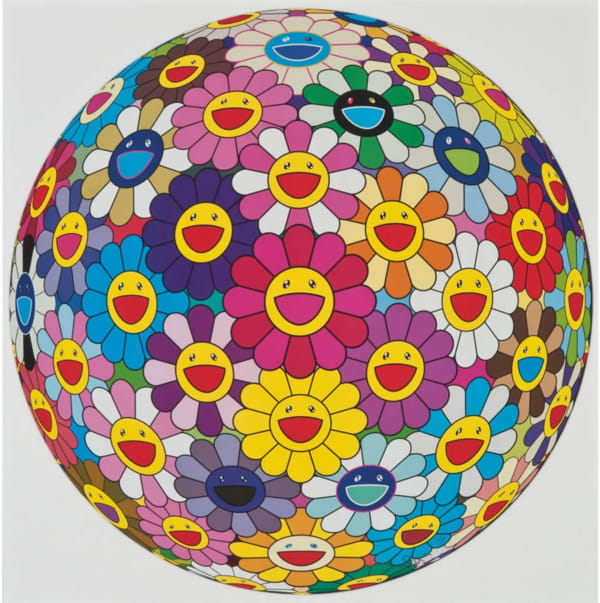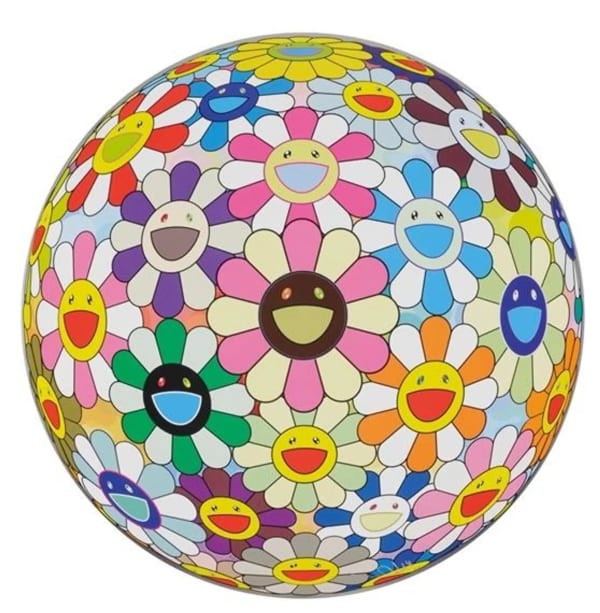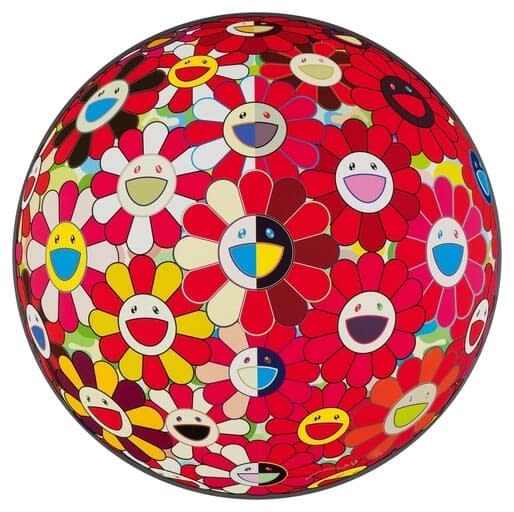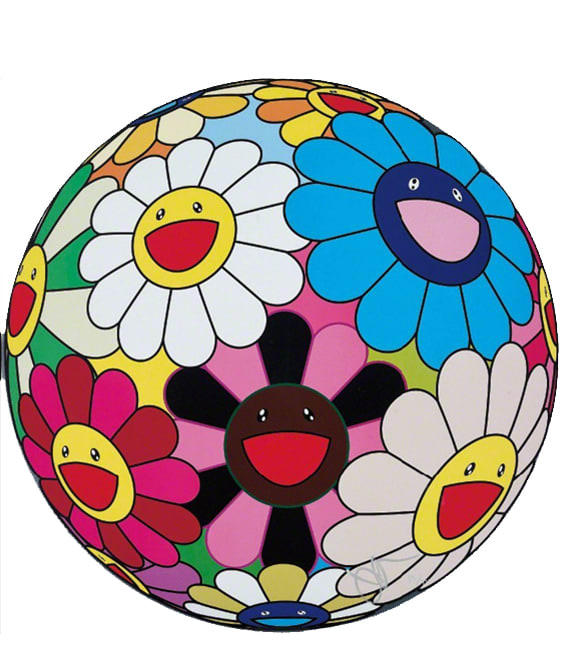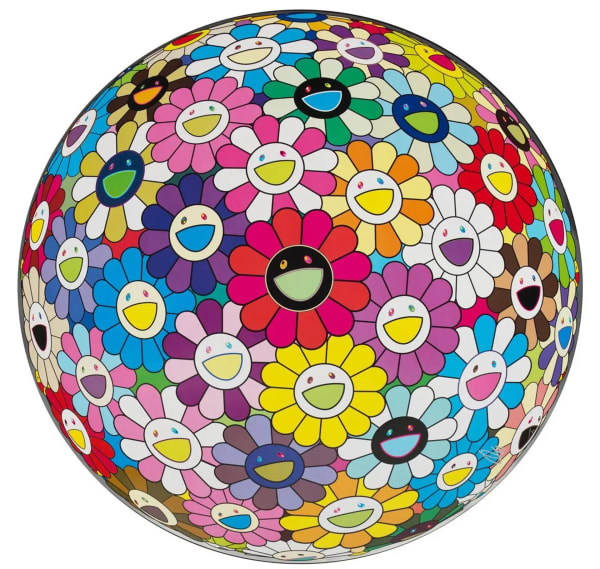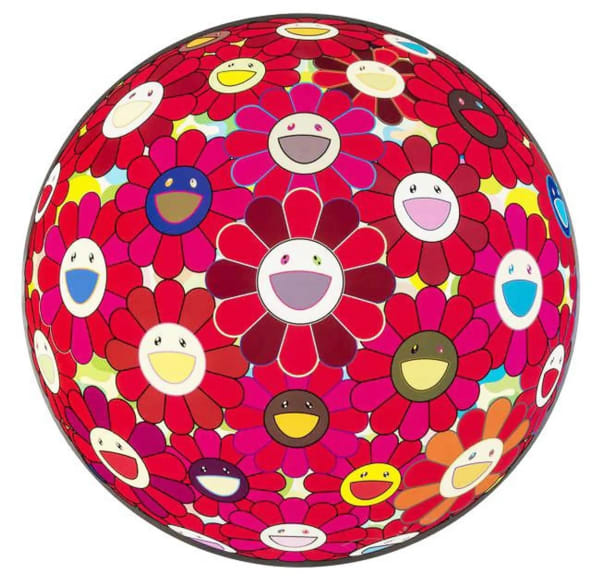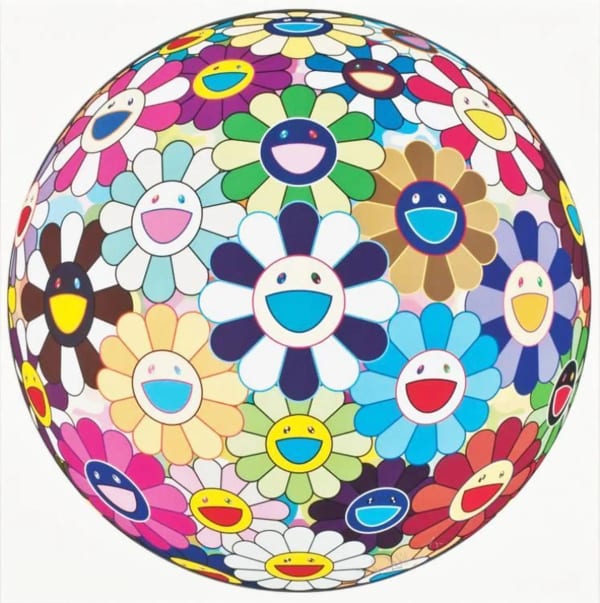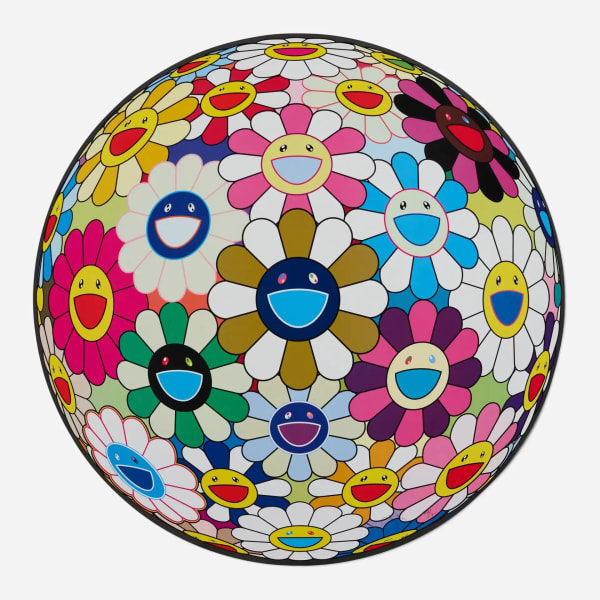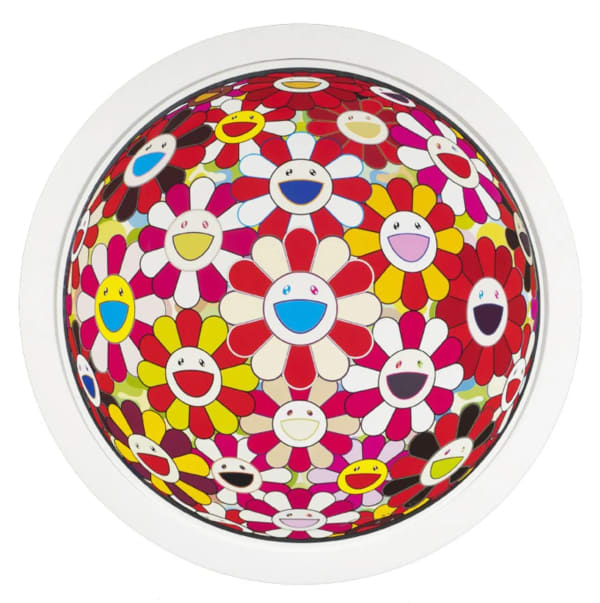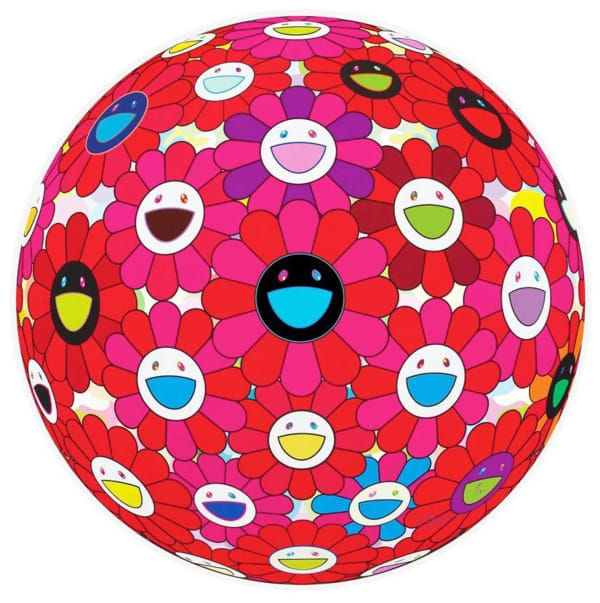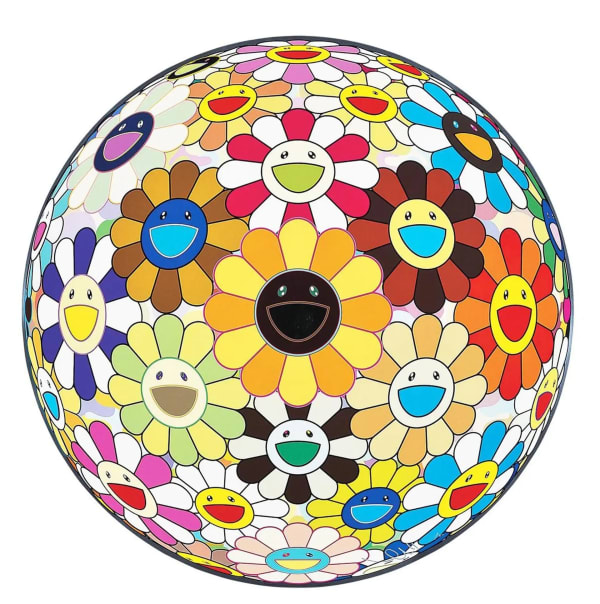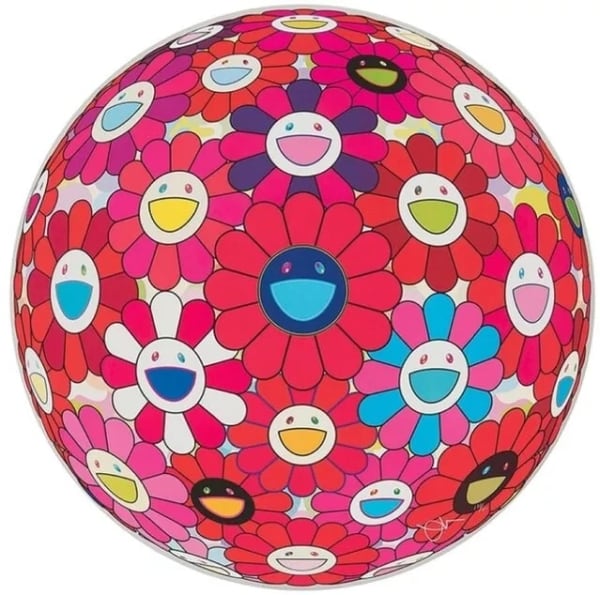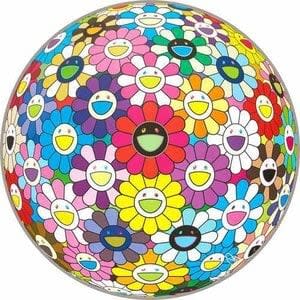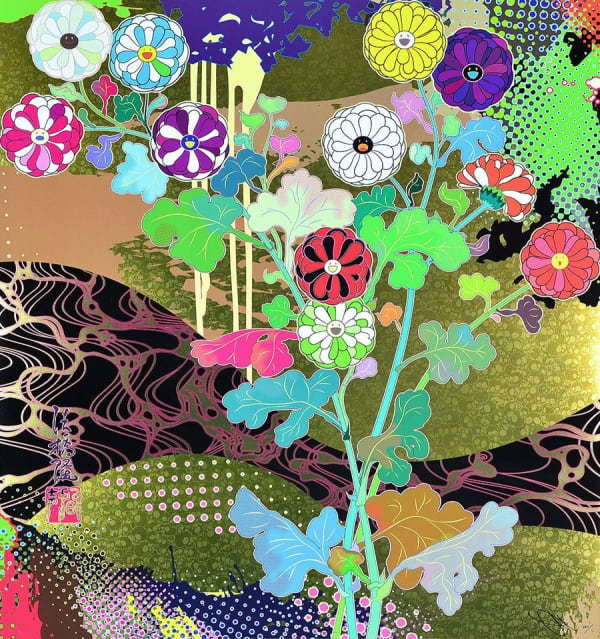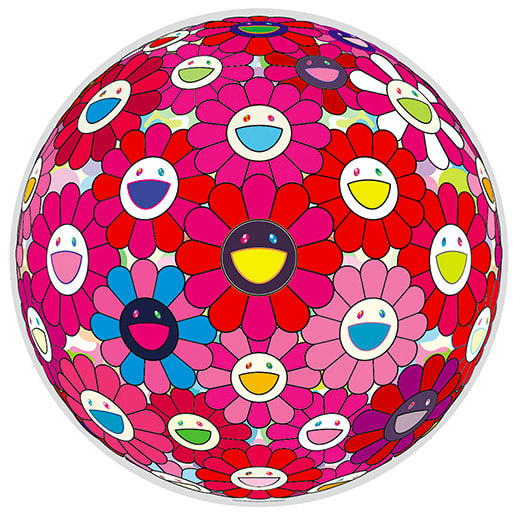
Takashi Murakami
Flowerball (3D) - Red, Pink, Blue, 2013
Offset lithograph
28 x 28 in
71.1 x 71.1 cm
71.1 x 71.1 cm
Edition of 300
Series: Flower Ball
Copyright The Artist
Takashi Murakami's Flowerball series is a vibrant and playful collection of works that encapsulate the artist's signature style, blending traditional Japanese art with contemporary pop culture. Murakami, a leading figure in the Superflat movement, is renowned for his ability to merge high and low art forms, and the Flowerball series is a prime example of this fusion.
The Flowerball series features spherical compositions adorned with Murakami's iconic smiling flowers, which have become a hallmark of his work. These flowers, often depicted with wide, cheerful grins and bright, saturated colors, are arranged in a densely packed, all-over pattern that wraps around the surface of each ball. The result is a dynamic, kaleidoscopic effect that is both visually captivating and emotionally uplifting.
Each piece in the series is characterized by its meticulous attention to detail and vibrant color palette. The flowers are rendered in various hues, from soft pastels to bold, primary colors, creating a sense of movement and energy. The spherical format of the Flowerball pieces adds a three-dimensional quality to the works, challenging the viewer’s perception and creating the illusion of depth.
The Flowerball series is deeply rooted in Murakami’s exploration of themes such as consumerism, mass production, and the commodification of art. The smiling flowers, while superficially cheerful, also carry a deeper, more complex meaning. They represent a blend of innocence and irony, reflecting Murakami's commentary on the superficiality of contemporary culture. The repetition of the flower motif across the series suggests a mass-produced, almost industrial quality, yet each work retains a sense of individuality and uniqueness.
Murakami's use of the flower motif also draws from traditional Japanese art, where flowers have long been a symbol of beauty, impermanence, and the natural cycle of life and death. By reinterpreting this motif in a contemporary context, Murakami bridges the gap between the past and the present, the traditional and the modern.
The Flowerball series has been widely acclaimed for its ability to evoke both joy and contemplation. The vibrant colors and playful imagery immediately draw the viewer in, while the deeper themes embedded in the work invite reflection on the complexities of modern life. Murakami’s Flowerball series is a testament to his ability to create art that is both accessible and thought-provoking, appealing to a wide audience while engaging with serious cultural and philosophical questions.
Overall, the Flowerball series is a quintessential example of Takashi Murakami's artistic vision, where pop culture meets traditional aesthetics, and where joy meets critique, creating works that are as visually delightful as they are intellectually engaging.
By 2013, Murakami had not only been named one of Time Magazine’s “100 Most Influential People," but he had also formed high-profile collaborations with celebrities like Kanye West and luxury brands such as Louis Vuitton. These partnerships underscored his dual influence in both the art world and popular culture, mirroring the celebrity associations and commercial success enjoyed by Andy Warhol, whom Murakami is often compared to. Like Warhol, who is known as the father of Pop Art, Murakami has been dubbed the 'Warhol of Japan' due to his similar fascination with mechanical repetition, mass production, and the merging of commercial and high art.
Murakami's academic background in 'nihonga'—a traditional style of Japanese painting—at the Tokyo University of Fine Arts and Music initially led him to a career within the conventional fine art world. However, feeling constrained by its politicized and insular nature, he pivoted towards contemporary styles, drawing significant inspiration from 'otaku' culture—a subculture steeped in technology and popular media. This shift was further enriched by his engagement with anime and manga, which are often considered elements of Japan's 'low' culture. By incorporating these aspects into his art, Murakami not only blurred the lines between 'high' and 'low' culture but also challenged the hierarchical distinctions prevalent in the art world.
Murakami's academic background in 'nihonga'—a traditional style of Japanese painting—at the Tokyo University of Fine Arts and Music initially led him to a career within the conventional fine art world. However, feeling constrained by its politicized and insular nature, he pivoted towards contemporary styles, drawing significant inspiration from 'otaku' culture—a subculture steeped in technology and popular media. This shift was further enriched by his engagement with anime and manga, which are often considered elements of Japan's 'low' culture. By incorporating these aspects into his art, Murakami not only blurred the lines between 'high' and 'low' culture but also challenged the hierarchical distinctions prevalent in the art world.
%3Cdiv%20class%3D%22artist%22%3ETakashi%20Murakami%3C/div%3E%3Cdiv%20class%3D%22title_and_year%22%3E%3Cspan%20class%3D%22title_and_year_title%22%3EFlowerball%20%283D%29%20-%20Red%2C%20Pink%2C%20Blue%3C/span%3E%2C%20%3Cspan%20class%3D%22title_and_year_year%22%3E2013%3C/span%3E%3C/div%3E%3Cdiv%20class%3D%22medium%22%3EOffset%20lithograph%20%3C/div%3E%3Cdiv%20class%3D%22dimensions%22%3E28%20x%2028%20in%3Cbr/%3E%0A71.1%20x%2071.1%20cm%3C/div%3E%3Cdiv%20class%3D%22edition_details%22%3EEdition%20of%20300%3C/div%3E%3Cdiv%20class%3D%22series%22%3E%3Cspan%20class%3D%22artwork_caption_prefix%22%3ESeries%3A%3C/span%3E%20Flower%20Ball%3C/div%3E
Related artworks
-
 Takashi MurakamiFlowerball: Koi/Red crowned Crane Vermillion: From Japan with Love
Takashi MurakamiFlowerball: Koi/Red crowned Crane Vermillion: From Japan with Love -
 Takashi MurakamiFlower Ball (Papyrus), 2013
Takashi MurakamiFlower Ball (Papyrus), 2013 -
 Takashi MurakamiFlower Ball (Want To Hold You), 2016
Takashi MurakamiFlower Ball (Want To Hold You), 2016 -
 Takashi MurakamiFlower Ball (Realm Of The Dead 3D), 2010
Takashi MurakamiFlower Ball (Realm Of The Dead 3D), 2010 -
 Takashi MurakamiFlower Ball (There Is Nothing Eternal In This World That Is Why You Are Beautiful), 2014
Takashi MurakamiFlower Ball (There Is Nothing Eternal In This World That Is Why You Are Beautiful), 2014 -
 Takashi MurakamiFlower Ball (Commos 3D), 2011
Takashi MurakamiFlower Ball (Commos 3D), 2011 -
 Takashi MurakamiFlower Ball (Letter to Picasso), 2013
Takashi MurakamiFlower Ball (Letter to Picasso), 2013 -
 Takashi MurakamiFlower Ball Awakening, 2016
Takashi MurakamiFlower Ball Awakening, 2016 -
 Takashi MurakamiFlower Ball (Sequoia Sempervirens), 2013
Takashi MurakamiFlower Ball (Sequoia Sempervirens), 2013 -
 Takashi MurakamiFlower Ball 3D Red, 2010
Takashi MurakamiFlower Ball 3D Red, 2010 -
 Takashi MurakamiFlower Ball (Algae Ball)
Takashi MurakamiFlower Ball (Algae Ball) -
 Takashi MurakamiFlower Ball (Thoughts On Matisse), 2015
Takashi MurakamiFlower Ball (Thoughts On Matisse), 2015 -
 Takashi MurakamiFlower Ball (Multicolour), 2014
Takashi MurakamiFlower Ball (Multicolour), 2014 -
 Takashi MurakamiFlower Ball (Pink), 2007
Takashi MurakamiFlower Ball (Pink), 2007 -
 Takashi MurakamiFlower Ball (Red Cliff), 2008
Takashi MurakamiFlower Ball (Red Cliff), 2008 -
 Takashi MurakamiFlower Ball (Kindergarten), 2010
Takashi MurakamiFlower Ball (Kindergarten), 2010 -
 Takashi MurakamiFlower Ball (Realm Of The Dead), 2009
Takashi MurakamiFlower Ball (Realm Of The Dead), 2009 -
 Takashi MurakamiFlower Ball (Margaret), 2008
Takashi MurakamiFlower Ball (Margaret), 2008 -
 Takashi MurakamiFlower Ball (Comprehending The 51st Dimension), 2014
Takashi MurakamiFlower Ball (Comprehending The 51st Dimension), 2014 -
 Takashi MurakamiFlower Ball (Autumn 3D) , 2004
Takashi MurakamiFlower Ball (Autumn 3D) , 2004 -
 Takashi MurakamiFlower Ball (Goldfish), 2008
Takashi MurakamiFlower Ball (Goldfish), 2008 -
 Takashi MurakamiFlower Ball (Blood 3D), 2007
Takashi MurakamiFlower Ball (Blood 3D), 2007 -
 Takashi MurakamiFlower Ball (The Magic Flute), 2010
Takashi MurakamiFlower Ball (The Magic Flute), 2010 -
 Takashi MurakamiFlower Ball (Burning Blood), 2018
Takashi MurakamiFlower Ball (Burning Blood), 2018 -
 Takashi MurakamiFlower Ball (Open Your Hands Wide), 2015
Takashi MurakamiFlower Ball (Open Your Hands Wide), 2015 -
 Takashi MurakamiFlower Ball (Sunflower), 2011
Takashi MurakamiFlower Ball (Sunflower), 2011 -
 Takashi MurakamiHey! You! Do You Feel What I Feel?, 2014
Takashi MurakamiHey! You! Do You Feel What I Feel?, 2014 -
 Takashi MurakamiHold Me Tight, 2017
Takashi MurakamiHold Me Tight, 2017 -
 Takashi MurakamiLotus Flower (Pink) , 2010
Takashi MurakamiLotus Flower (Pink) , 2010 -
 Takashi MurakamiThe Time Of Celebration, 2015
Takashi MurakamiThe Time Of Celebration, 2015 -
 Takashi MurakamiThinking Matter (Red), 2016
Takashi MurakamiThinking Matter (Red), 2016 -
 Takashi MurakamiThoughts on Picasso, 2015
Takashi MurakamiThoughts on Picasso, 2015 -
 Takashi MurakamiWarhol/Silver, 2009
Takashi MurakamiWarhol/Silver, 2009



